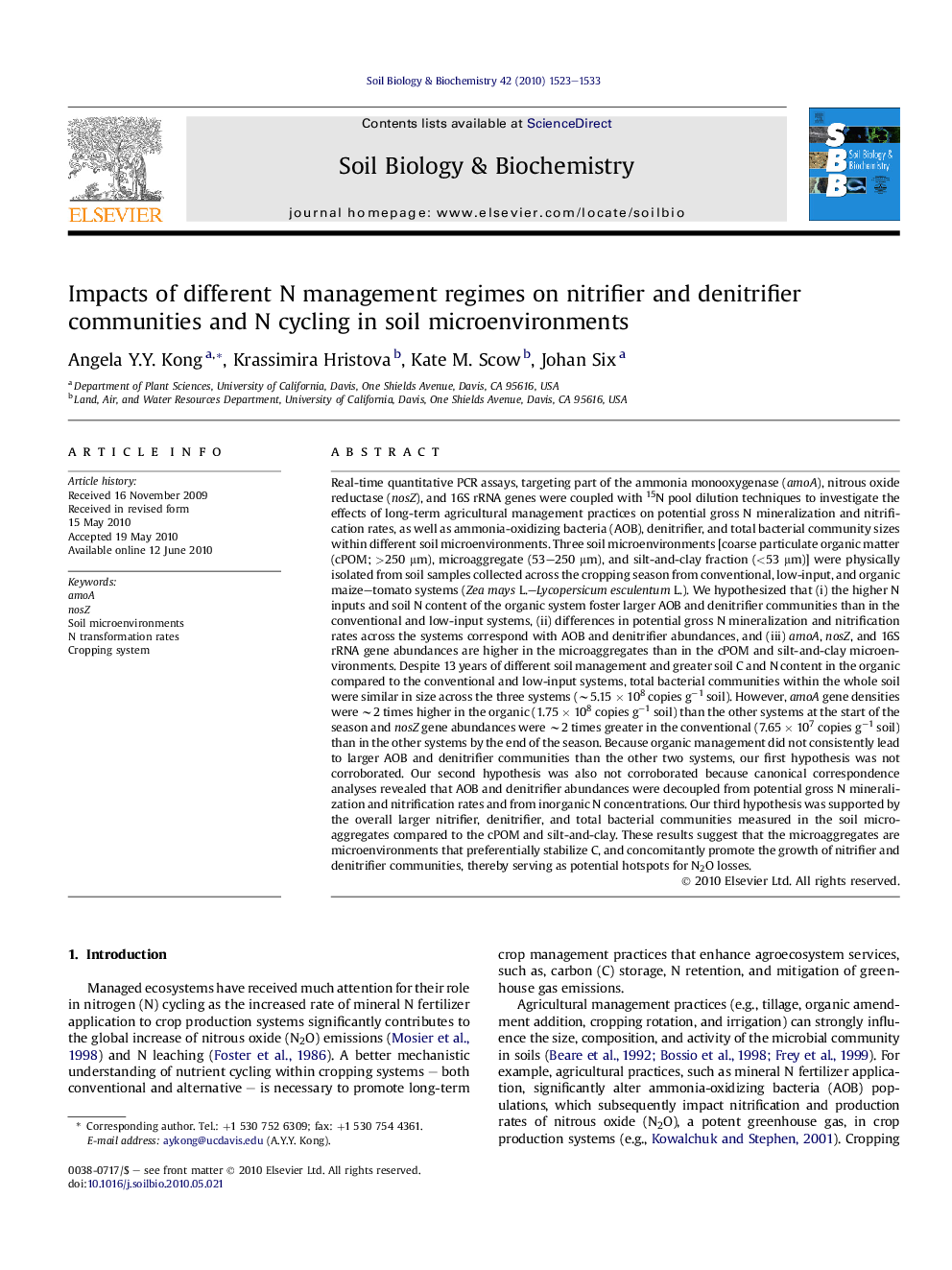| کد مقاله | کد نشریه | سال انتشار | مقاله انگلیسی | نسخه تمام متن |
|---|---|---|---|---|
| 10846121 | 1070002 | 2010 | 11 صفحه PDF | دانلود رایگان |
عنوان انگلیسی مقاله ISI
Impacts of different N management regimes on nitrifier and denitrifier communities and N cycling in soil microenvironments
دانلود مقاله + سفارش ترجمه
دانلود مقاله ISI انگلیسی
رایگان برای ایرانیان
موضوعات مرتبط
علوم زیستی و بیوفناوری
علوم کشاورزی و بیولوژیک
دانش خاک شناسی
پیش نمایش صفحه اول مقاله

چکیده انگلیسی
Real-time quantitative PCR assays, targeting part of the ammonia monooxygenase (amoA), nitrous oxide reductase (nosZ), and 16S rRNA genes were coupled with 15N pool dilution techniques to investigate the effects of long-term agricultural management practices on potential gross N mineralization and nitrification rates, as well as ammonia-oxidizing bacteria (AOB), denitrifier, and total bacterial community sizes within different soil microenvironments. Three soil microenvironments [coarse particulate organic matter (cPOM; >250 μm), microaggregate (53-250 μm), and silt-and-clay fraction (<53 μm)] were physically isolated from soil samples collected across the cropping season from conventional, low-input, and organic maize-tomato systems (Zea mays L.-Lycopersicum esculentum L.). We hypothesized that (i) the higher N inputs and soil N content of the organic system foster larger AOB and denitrifier communities than in the conventional and low-input systems, (ii) differences in potential gross N mineralization and nitrification rates across the systems correspond with AOB and denitrifier abundances, and (iii) amoA, nosZ, and 16S rRNA gene abundances are higher in the microaggregates than in the cPOM and silt-and-clay microenvironments. Despite 13 years of different soil management and greater soil C and N content in the organic compared to the conventional and low-input systems, total bacterial communities within the whole soil were similar in size across the three systems (â¼5.15 Ã 108 copies gâ1 soil). However, amoA gene densities were â¼2 times higher in the organic (1.75 Ã 108 copies gâ1 soil) than the other systems at the start of the season and nosZ gene abundances were â¼2 times greater in the conventional (7.65 Ã 107 copies gâ1 soil) than in the other systems by the end of the season. Because organic management did not consistently lead to larger AOB and denitrifier communities than the other two systems, our first hypothesis was not corroborated. Our second hypothesis was also not corroborated because canonical correspondence analyses revealed that AOB and denitrifier abundances were decoupled from potential gross N mineralization and nitrification rates and from inorganic N concentrations. Our third hypothesis was supported by the overall larger nitrifier, denitrifier, and total bacterial communities measured in the soil microaggregates compared to the cPOM and silt-and-clay. These results suggest that the microaggregates are microenvironments that preferentially stabilize C, and concomitantly promote the growth of nitrifier and denitrifier communities, thereby serving as potential hotspots for N2O losses.
ناشر
Database: Elsevier - ScienceDirect (ساینس دایرکت)
Journal: Soil Biology and Biochemistry - Volume 42, Issue 9, September 2010, Pages 1523-1533
Journal: Soil Biology and Biochemistry - Volume 42, Issue 9, September 2010, Pages 1523-1533
نویسندگان
Angela Y.Y. Kong, Krassimira Hristova, Kate M. Scow, Johan Six,